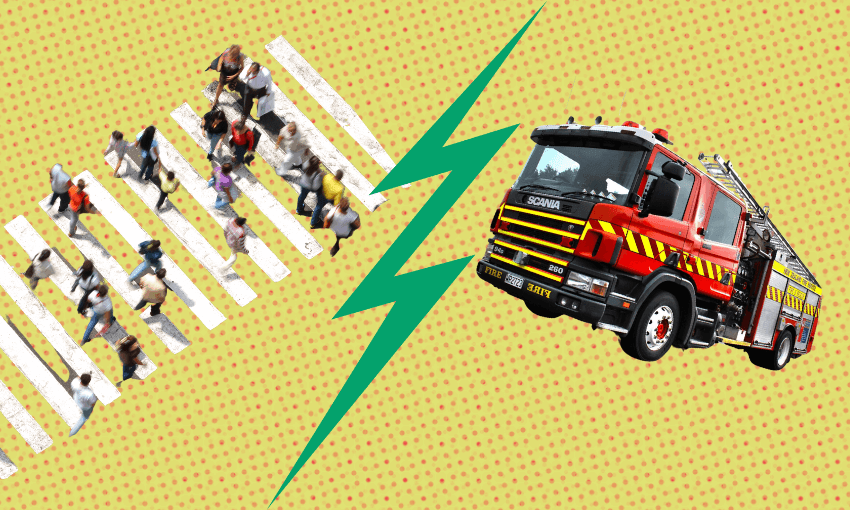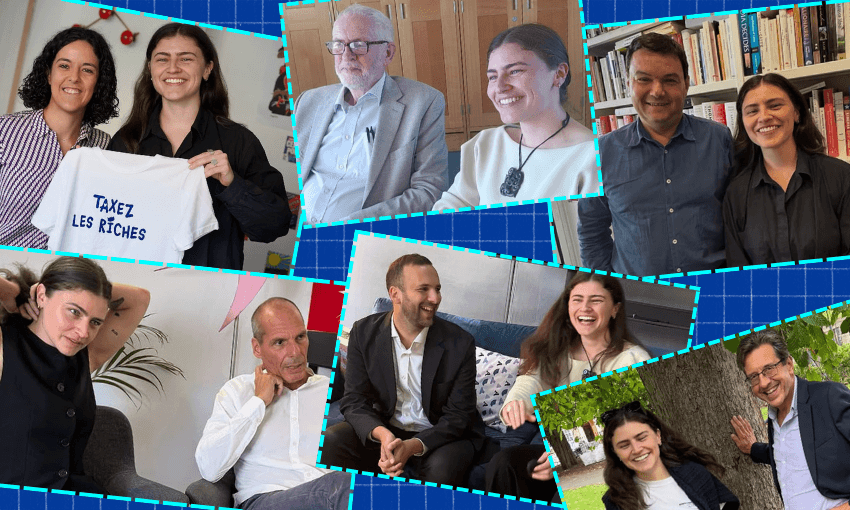There’s an awkward conflict between safer street design and emergency service response times. Joel MacManus explains.
Last month, a person died in a medical emergency in Karori that was attended by paramedics and firefighters. That person was apparently a close friend of councillor Ray Chung. Chung is a vocal opponent of speed bumps, raised pedestrian crossings, cycle lanes and other street safety initiatives that sometimes inconvenience drivers.
Chung immediately saw that death for what it was; not just a tragedy, but an opportunity to start another stupid argument. He blamed three raised pedestrian crossings in Karori for slowing the fire engine’s response time. While he didn’t explicitly say the pedestrian crossings were responsible for his friend’s death, it was the clear implication. “Every second counts,” he told The Post, a statement that is vague enough to always be somewhat true and impossible to disprove.
Fire and Emergency New Zealand didn’t comment on this particular incident, but has raised concerns about several recent Wellington street changes. Firefighters said the Island Bay cycle lane would mean there was less room for cars to pull over, speed bumps in Brooklyn would delay response times, and the Adelaide Road cycle lane would cause “quite significant traffic delay and congestion issues”. When speaking about the council’s overall cycleway rollout plan in 2022, assistant area commander Michael Dombroski urged the council not to “roll the dice with the public’s welfare”.
The conflict between safer street design and emergency service response times is common around the world. Firefighters have opposed similar changes in New York, Baltimore and Sydney. In Los Angeles, the firefighters union bankrolled a political advertising campaign to oppose a citywide street and footpath improvement project.
Fire departments have a narrow safety remit. They think primarily about getting to their jobs and saving lives. It’s not their job to think about how a street change will affect carbon emissions or retail sale figures or the rates of kids biking to school, nor should it be.
A Fire and Emergency spokesperson told The Spinoff: “Fire and Emergency New Zealand supports measures that are clearly intended to improve safety for everyone on our roads, but having to slow down for features designed to reduce speed will of course impact crews’ response times which in turn may influence the outcome of an event.
“Our people will continue to work closely with territorial authorities across the country when traffic-calming measures are being considered to ensure they understand the complexities and potential impacts.”
Chung also claimed am ambulance had been delayed going down Ngaio Gorge because of the cycleway. Wellington Free Ambulance avoided taking a position. “At this time we are not entering the debate or conversation publicly and maintain our view that the overarching objective of initiatives that improve safety for all road users are positive for our community,” a spokesperson said.
Last year, 341 people died in car crashes in New Zealand. On average, 36 pedestrians are killed and 1,000 are injured every year in New Zealand. More pedestrians and cyclists die per capita in New Zealand cities than European cities.
Safer street changes aren’t just about reducing deaths and injuries. There are a whole bunch of co-benefits you unlock simply by improving perceptions of safety. When you don’t have to worry about you or your kids getting hit by a car, it tends to change your behaviour. Street-level improvements around retail areas make them nicer and calmer places to be, which keeps people around longer, spending more money. Cycleways that feel safe make more people want to bike. Cycling on dangerous roads turns people off, especially women and children. There is some number of adult men who will be willing to bike in almost any traffic conditions, but cities with the most women and children on bikes are almost perfectly correlated with high perceptions of safety.
It’s really important to have a public discussion about street design. Streets are negotiated spaces, owned collectively by everyone, so everyone should be part of the conversation about their form. Almost every city in the world is taking steps to move away from car-centric design to adopt more people-friendly streets. Wellington City Council is embracing that change with more enthusiasm and pace than most. There will be mistakes – for example, the proposed design of Thorndon Quay goes a bit overboard – but, with a bit of creativity, there will also be solutions.
After some feedback, Wellington City Council staff added miniature speed bumps to the cycleway outside Wellington Central Station, to warn cyclists to slow down in case a fire engine is pulling out. Rather than pushing for fully pedestrianised streets, most urbanists are increasingly adopting “open streets”, like Barcelona’s Superblocks, pedestrian-priority spaces that don’t completely block accessibilitly for emergency services. San Francisco, Singapore and Stockholm are among cities that have adopted miniature fire trucks that are better at manoeuvring narrow streets in dense areas. Firefighters in Amsterdam can drive on wide cycleways in emergencies. New Zealand typically uses its smallest fire engines in mostly rural areas.
As a city, if we have street design debates in good faith, we can get great outcomes. But if politicians like Chung start blaming every tragic death on pedestrian crossings and media keep credulously reporting their bad faith claims, it’s going to devolve into a tedious, bad faith shitfight.



